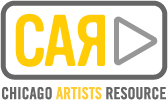Today we are so lucky to feature a guest post from Lisa Davis, a museum educator right here in Chicago who is dedicated to making museums accessible to everyone. Thank you Lisa! Lisa is one of the people helping make PLEASE TOUCH THE ARTWORK a reality! We have just a little over a month left to raise funds for this project, so please stop by our
kickstarter page and pledge to help make art accessible to the visually impaired!
'How do you experience an art museum? What do you see, feel, smell, and touch? How do you relate to the environment of the museum and the visual works around you? What do you first think about when viewing a work? What personal connections do you make with an art piece and how does that happen?
As a museum educator these are all questions I consider for my audience. I specifically work with teachers and students (K-12), writing tours of the collections and traveling exhibitions and creating resources the teachers can use to integrate art into their classroom learning. But, more than anything else I do, I feel my most important role is to ensure all visitors have the opportunity to experience the visual arts. I believe that there should be no constraints—emotional, physical, financial, or otherwise— as obstacles to this important personal experience.
The questions above, you will notice, are often based on the sensory understanding. Before a viewer can notice details, make connections to any art historical context, or interpret a work, they will experience it through their senses first, as with any moment in life. So when thinking about this sensory reading, how do we include people who are without one or more of these senses? In the context of the environment in which I work, the art museum, the most outstanding concern is the visual.
How can we ensure a person with low or no vision is able to experience a visual art piece? I used to ask this question as, “How can we ensure…..is able to experience a visual piece in the same way as a person with no impairment?” until I realized I was asking the wrong question. Instead of trying to force the square peg, I needed to reconsider my definition of how people see.
As I begin to see more and more art museums developing “touch tours” or including multi-sensory tools for visitors, it seems my belief is shared by many educators in the art/museum world. An added benefit is how these multi-sensory tools can be integrated to enhance the experience for others as well. Often museums will have large print text of wall labels and most offer audio guides. Over the past few years efforts have increased: Some museums are allowing—with gloves, small groups and special permissions—viewers to touch, to feel the contours of a sculpture. Some have developed tours that use music to describe the emotional sense or dynamics of a work, include three-dimensional recreations to touch, and have materials, similar to those used in the work itself, available to touch, or even smell, along the way. Tours are led by docents well-educated in the Sighted Guide technique and Verbal Description, as they guide groups of varying sight abilities through the museum.
There are really incredible resources available to those of us who strive to be inclusive. Art Education for the Blind (
www.artbeyondsight.org) is especially strong. This organization out of New York, established in 1987, has developed a wide variety of resources for teachers, museum educators, and other seeking to bring the visual arts to everyone. They also provide accessibility training for museum staff, which may also include Visitor Services departments, to help ensure a positive museum experience overall. AEB and the American Association for Museums are two organizations which have begun to research and publish information about accessibility in museums. The National Endowment for the Arts’ Office for AccessAbility is a wonderful resource as well, as we attempt to meet and exceed government and ADA standards and regulations.
I understand the logistical challenges and sometimes financial obstacles that keep institutions from moving forward quickly. I know there are bureaucratic issues that present barriers at some museums, and I know accessibility is one pet project among many. I am fairly new to this field and am not informed enough to speak on how this topic is being addressed in the larger scale, internationally, or in Museum Studies programs, which turn out amazing museum educators annually. But from a personal perspective I have seen great strides made in the art world to include all visitors in the visual experience. It no longer seems museums are considered, as one Newsweek article quoted in 2009, "essentially visual institutions.” The art museum has become an experience for seeing, in every sense of the word.'
Submitted by Lisa Davis, Museum Educator, 2011






